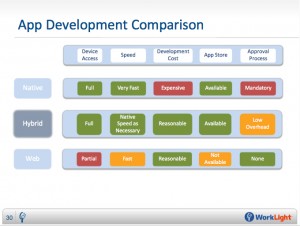 I recently had an idea and thought, “hey, that would make a neat app.” I’m not a developer nor do I play one on TV, so I looked into what it would take to develop an app and decided to lay out the process for neophytes like me.
I recently had an idea and thought, “hey, that would make a neat app.” I’m not a developer nor do I play one on TV, so I looked into what it would take to develop an app and decided to lay out the process for neophytes like me.
After starting off my research with several “Easy Steps to Creating an App” articles, I clicked into more detail and began to feel a little like Alice heading down the rabbit hole.
I have a love-hate relationship with the “Easy Step” approach to advice. I love that such advice makes it seem possible to do something, but I hate that it glosses over the complexities that are required to do something well.
A single step can include multiple thought-provoking questions that are key to your project. A single step can take weeks to fully explore and refine. A single step can make or break your entire project.
When considering whether or not you should create an app in the first place, it’s a good idea to become familiar with the landscape. In the early days of apps, it seemed like a great way to create an additional revenue stream at $.99, $1.99 or $2.99 a pop. The market was pretty open and people loved to tinker. But times have changed.
With an estimated 1 million apps available on the four major U.S. platforms, there is a glut of apps out there and users aren’t flocking to them as much as developers might wish. Additionaly apps will reach only a portion (less than half) of the U.S. mobile phone market.
Despite that, let’s say you are married to your initial idea and ready to move forward. What do you need to know?
Here are some basic steps for app development along with more detailed explorations that go along with them.
Basic steps:
- Idea
- Research
- Define Goal
- Budget
- Determine Best Application Type
- Determine Platform
- Map It Out
- Design & Develop
- Test
- Submit & Launch
- Market
- Measure
Step 1: Idea
Have an idea. Duh. App development reminds me a bit of the gold rush. People are hot to launch apps and strike it rich. Some people are so desperate to develop an app that they don’t sit down and do a little brainstorming. Once you’ve had that eureka moment or narrowed down your ideas to a viable winner, it’s time to be a killjoy.
Step 2: Research
Doing a little research can take you a long way. Play devil’s advocate. Start poking holes in your idea. Is there already an app out there that does the same thing? Is there an audience for your app? Is there an existing market for the idea that you can plug into? Is your idea conducive to mobile use? What’s the purpose of your app?
Step 3: Define Your Goal(s)
This step may be done along with Step 1 or separately. Think about the big picture. What are you hoping to get from the process? Are you after money? Fame? A new skill set? You won’t know when or if you’ve accomplished what you set out to do if you have no clear sense of the big picture to begin with. Do you want to reach users? Extend a brand? Given your goal, what’s the best way to execute your app?
Step 4: Budget
How much does it cost to produce an app? Mashable estimates that a very basic app will run about $10,000 for coding alone. If you want to program your own app, what does that cost? Google Android and Blackberry provide their development kits for free. Apple and Microsoft charge developer fees to access their kits. All the platforms take 30% of your sales price.
Step 5: Determine the Best Application Type
“App” is one of the major buzzwords of the moment. But it doesn’t mean it’s the right answer to every puzzle. Would a mobile website be a better option for your idea? Is a native app the way to go? How about a cross between the two called a hybrid? WorkLight has a great presentation that talks about the pros and cons of each of these options. In general, mobile websites are faster and cheaper to produce, but they don’t provide the best user experience. Native mobile apps, those apps developed specifically for a mobile platform, often have a better user experience, but the tradeoff is the increased time and money required to develop for a native mobile app. Hybrids can often be the best of both worlds.
Step 6: Determine Your Platform
In the U.S. there are four major platforms and they all have different coding requirements. To develop a native app for one is not to develop for all. What is the market reach for each platform? Is your target audience more likely to use a certain platform? When developing a native app, you’ll need to settle on a platform.
Step 7: Map It Out
You have the big idea. You’ve scoped out the landscape. You’ve settled on a route. Now it’s time to get down in the weeds. Saying “I want an app that will do X, Y and Z and integrate over Facebook” will just land you in a boggy mire. Create a user flow – also called a functionality layout or user map. Actually draw the landing page. Identify the different elements on the page. For each element, describe the user interaction with that element. Define the expected behavior of that element once the user has interacted with it. Where does it take the user? What are the app’s main pages? Which of the device’s native features does the app need to work with? Does the app pull data from a website? Does it push data? Does it sync with other programs? Does it integrate with social media? If a user presses instead of slides, what happens? Map out every single element and interaction.
Step 8: Design & Develop
Only eight steps in and we’re ready to develop! But wait. You need to consider design, too. Your app must not only be functional, it must also look good. No one will care how brilliant your initial idea was if the app itself is unstable or ugly. The first question of this step is whether you want to hire people to design and develop for you or do it yourself (DIY). Your idea needs more than the basic coding. You need a coder and designer working in tandem, which can start to look more like $20,000, according to Mashable. In your mapping process, you may have laid out features that might cost you more. You don’t want to skimp when hiring. Price out competitors to get a reasonable deal, but don’t go with Marty’s Qwik Apps either. If you want to develop yourself, you’ll need the developer kit from the platform of your choice to get started. You might also consider using a mockup service to help with design concepts. Services like MockApp will cost additional money.
Step 9: Test
You now have a shiny new app. It’s been delivered on time and under budget. Time to upload it, right? Wrong. Time to test. Remember that mapping you did early on? It’s time to see if your app works as envisioned. Walk through every screen. Perform every action. Test every expected result. Make sure it’s not buggy. Then turn it over to friends and strangers alike. Testing services such as TestFlight will deliver your app to potential users for them to kick the tires. Don’t risk launching and getting terrible reviews because you neglected to test.
Step 10: Submit & Launch
Once you’re confident the app is stable and ready to launch, submit it to the market platform of your choice. Some, like Apple, must approve your app before you can put it up for sale in their market. Imagine going through this entire process, spending all that money, and having Apple reject your app. Take your time for every part of this process. For Step 10, you’ll also need to consider your pricing. Cheaper does not always guarantee more downloads. If you list for free, you could display in-app ads but these can be disruptive to the user experience. Free might not be the way to go. If you have revenue goals in mind, how many downloads must you sell to hit that revenue, taking into account the platform usually takes 30% of your sales cost? $1.99 might start to look pretty good.
Step 11: Market
It’s common to post news of your app’s launch on social media and leave it at that, but don’t gloss over this crucial step. Get the word out about your app. There is a glut of applications and getting noticed can make a huge difference. Not all promotion is created equal. What needs to go in your app description? What’s your strategy? What groups will you target? What reviewers can you focus on? Should you offer a price reduction for a limited time? What can the difference between placement in Apple’s What’s Hot and New & Notable sections mean in terms of your downloads? In a recent Mashable experiment, the difference meant nearly twice the downloads.
Step 12: Measure
Remember those goals you identified way back when? Now’s the time to start looking at whether or not you’re doing what you set out to do. How many downloads have you had? What is the average time spent on your app? Are you gaining traction in the market or spinning your wheels? Just like with your daily shampoo (lather, rinse, repeat), use the metrics to see if you need to revisit any steps. Perhaps you need to market more aggressively. Maybe you need to push out an update to fix bug reports or add new functionality. Measurement will let you know what you need to focus on in your app’s extended life.
App development is not as easy as it might seem. It is not a get rich quick plan. Each of these steps takes thought and planning. But anything worth doing is worth doing right, right?
And it’s no coincidence that there are 12 Steps here. If you’re even considering developing an app, you might have a mobile problem… that’s worth exploring, too. But there’s a whole different set of questions that go along with that.




{ 1 trackback }